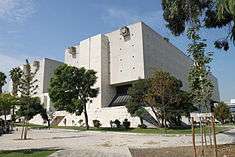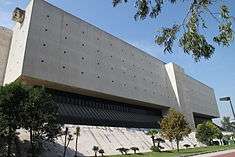Torre do Tombo National Archive
| National Archive of Torre do Tombo (Arquivo Nacional da Torre do Tombo) | |
| National Archive of the Tower of the Tome | |
| National Archive (Arquivo Nacional) | |
| The front facade of the large national archive building in center-north Lisbon | |
| Official name: Torre do Tombo | |
| Name origin: Torre do Tombo, Portuguese for Tower of the Tome; the name goes back to when the National Archives were housed in a tower of the medieval Saint George's Castle. | |
| Country | |
|---|---|
| Region | Lisbon |
| Sub-region | Grande Lisboa |
| District | Lisbon |
| Municipality | Lisbon |
| Architects | Ateliers Associados, Arsénio Raposo Cordeiro, A.N. de Almeida, M. Sheppard Cruz |
| Style | Modern |
| Materials | Limestone, Concrete |
| Origin | 1378 |
| Owner | Portuguese Republic |
| For public | Public |
| Visitation | Closed (Mondays and on 1 January, Easter Sunday, 1 May and 25 December) |
| Easiest access | Alameda da Universidade |
| Management | Instituto Gestão do Patrimonio Arquitectónico e Arqueológico |
 Location of the National Archive within the municipality of Lisbon | |
| Wikimedia Commons: Torre do Tombo | |
| Website: http://antt.dgarq.gov.pt/ | |
The National Archive of Torre do Tombo (Portuguese: Arquivo Nacional da Torre do Tombo, [ɐɾˈkivu nɐsjuˈnaɫ dɐ ˈtoʁɨ ðu ˈtõbu]) is the Portuguese national archive established in 1378, located in center-north Lisbon, and renamed the Instituto dos Arquivos Nacionais (Institute of the National Archives) in 2009.
History


The archive is one of the oldest institutions in Portugal, since its installation in one of the towers of the castle in Lisbon, occurring during the reign of Ferdinand I, and likely in 1378 (the date where the first testimonal originated). The archive served as the King's and nobilities' reference, with documents supporting the administration of the kingdom and overseas territories, and documenting the relationships between the State and foreign kingdoms.
Following the events of the 1755 Lisbon earthquake, the High-Guardian of the archives, Manuel da Maia, was responsible for saving the contents of the Torre do Tombo. At 75 years old, Maia personally led the safe-guarding team to São Jorge Castle, where the archives were located, and saved nearly 90,000 pieces, accumulated between 1161 and 1696. He ordered the construction of provisionary barracks to store the contents of the archives and immediately made a request to Sebastião José de Carvalho e Melo, King Joseph I’s prime-minister, for a new permanent home for the archives, which would eventually be granted to him in the form of the Convent of São Bento (which now houses the parliament of Portugal).
In 1982 a public tender was issued for the construction of the new Torre do Tombo archive building, and was won by the Ateliers Associados, represented by Arsénio Raposo Cordeiro, with M. Sheppard Cruz and A.N. de Almeida.[1] The cornerstone was laid in 1985, in an official ceremony. The sculptor José Aurélio was invited to sculpt the gargoyles in 1987, which completed between 1988-1990 (in conjunction with mason José Rodrigues and builder Júlio Mesão.[1]
In 1990, the archive in the National Palace of São Bento was moved to the new building, before the 21 December inauguration.[1]
On 22 December 2010, the DRCLVTejo proposed classifying the building as a municipal property of interest, which was supported by the director of the IGESPAR.[1] On 17 May 2011, an announcement was published regarding the process to classify the building, and by August, a formal request to make the building a municipal property of interest was formalized by DRCLVTejo.[1] The National Council for Culture decided on 10 October 2011, that a classification was warranted, and provided their support. On 30 November 2011, a decision on the classification of this building was approved, and a Special Protection Zone was established.[1]
Collections
Among the significant collections at the Arquivo are items relating to the Portuguese explorations and discoveries in Africa, Asia and Latin America. The Corpo Cronológico (Chronological Corpus), a collection of manuscripts on the Portuguese discoveries, was inscribed on UNESCO's Memory of the World Register in 2007 in recognition of its historical value "for acquiring knowledge of the political, diplomatic, military, economic and religious history of numerous countries at the time of the Portuguese Discoveries." [2] Another item relating to the Portuguese discoveries, the Carta de Pêro Vaz de Caminha (Letter from Pêro Vaz de Caminha), was also inscribed on the Memory of the World Register in 2005. This letter is the first document describing the land and people of what became Brazil.[3]
See also
References
- Notes
- 1 2 3 4 5 6 Bandeira, Filomena (2002). SIPA, ed. "Torre do Tombo (PT031106090714)" (in Portuguese). Lisbon, Portugal: SIPA – Sistema de Informação para o Património Arquitectónico. Retrieved 13 October 2012.
- ↑ "Corpo Cronológico (Collection of Manuscripts on the Portuguese Discoveries)". UNESCO Memory of the World Programme. 2008-05-16. Retrieved 2009-12-14.
- ↑ "Letter from Pêro Vaz de Caminha". UNESCO Memory of the World Programme. 2008-05-16. Retrieved 2009-12-14.
- Sources
- Afonso, Luís U. (2005), "As gárgulas da Torre do Tombo", ARTIS (in Portuguese), 4, Lisbon, Portugal: Instituto de História da Arte da Faculdade de Letras de Lisboa, pp. 441–466
- Pedreirinho, José Manuel (1994), Dicionário de arquitectos activos em Portugal do Séc. I à actualidade (in Portuguese), Porto, Portugal: Edições Afrontamento
Coordinates: 38°45′17″N 9°09′23″W / 38.7546°N 9.1565°W